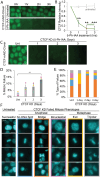This is a preprint.
CTCF maintains pericentromere function and mitotic fidelity
- PMID: 40502007
- PMCID: PMC12157408
- DOI: 10.1101/2025.05.30.657091
CTCF maintains pericentromere function and mitotic fidelity
Abstract
In mitosis the duplicated genome is aligned and accurately segregated between daughter nuclei. CTCF is a chromatin looping protein in interphase with an unknown role in mitosis. We previously published data showing that CTCF constitutive knockdown causes mitotic failure, but the mechanism remains unknown. To determine the role of CTCF in mitosis, we used a CRISPR CTCF auxin inducible degron cell line for rapid degradation. CTCF degradation for 3 days resulted in increased failure of mitosis and decreased circularity in post-mitotic nuclei. Upon CTCF degradation CENP-E is still recruited to the kinetochore and there is a low incidence of polar chromosomes which occur upon CENP-E inhibition. Instead, immunofluorescence imaging of mitotic spindles reveals that CTCF degradation causes increased intercentromere distances and a wider and more disorganized metaphase plate, a disruption of key functions of the pericentromere. These results are similar to partial loss of cohesin, an established component of the pericentromere. Thus, we reveal that CTCF is a key maintenance factor of pericentromere function, successful mitosis, and post-mitotic nuclear shape.
Conflict of interest statement
Competing interests The authors declare not competing interests.
Figures




Similar articles
-
CTCF is essential for proper mitotic spindle structure and anaphase segregation.Chromosoma. 2024 Jul;133(3):183-194. doi: 10.1007/s00412-023-00810-w. Epub 2023 Sep 20. Chromosoma. 2024. PMID: 37728741
-
CTCF is essential for proper mitotic spindle structure and anaphase segregation.bioRxiv [Preprint]. 2023 Jan 10:2023.01.09.523293. doi: 10.1101/2023.01.09.523293. bioRxiv. 2023. Update in: Chromosoma. 2024 Jul;133(3):183-194. doi: 10.1007/s00412-023-00810-w. PMID: 36712070 Free PMC article. Updated. Preprint.
-
Carbamazepine versus phenytoin monotherapy for epilepsy: an individual participant data review.Cochrane Database Syst Rev. 2017 Feb 27;2(2):CD001911. doi: 10.1002/14651858.CD001911.pub3. Cochrane Database Syst Rev. 2017. Update in: Cochrane Database Syst Rev. 2019 Jul 18;7:CD001911. doi: 10.1002/14651858.CD001911.pub4. PMID: 28240353 Free PMC article. Updated.
-
Extrusion fountains are restricted by WAPL-dependent cohesin release and CTCF barriers.Nucleic Acids Res. 2025 Jun 20;53(12):gkaf549. doi: 10.1093/nar/gkaf549. Nucleic Acids Res. 2025. PMID: 40586309 Free PMC article.
-
Cost-effectiveness of using prognostic information to select women with breast cancer for adjuvant systemic therapy.Health Technol Assess. 2006 Sep;10(34):iii-iv, ix-xi, 1-204. doi: 10.3310/hta10340. Health Technol Assess. 2006. PMID: 16959170
References
-
- Barisic M, Aguiar P, Geley S, and Maiato H (2014). Kinetochore motors drive congression of peripheral polar chromosomes by overcoming random arm-ejection forces. Nat Cell Biol 16, 1249–1256. - PubMed
Publication types
Associated data
Grants and funding
LinkOut - more resources
Full Text Sources
